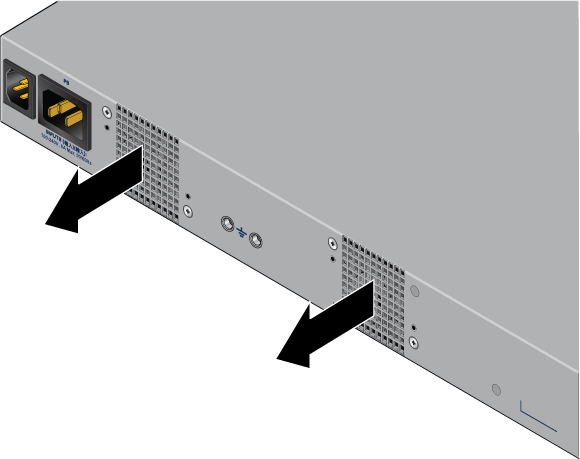Preparation
This section describes the initial setup and preparation for installing the Arista 7220R Series Enterprise WAN routers.
The following topics are covered in this section:
Site Selection
The following criteria should be considered when selecting a site to install the router:
-
Temperature and Ventilation: For proper ventilation, install the router with ample airflow to the front and back of the router.
Important: To prevent the device from overheating, do not operate it in an area where the ambient temperature exceeds 104°F (40°C).Pour empêcher l’interrupteur de surchauffe, ne pas utiliser il dans une zone où la température ambiante est supérieure à 104°F (40°C).
-
Airflow Orientation: The fan vents determine the airflow direction through front to rear of the router.
Figure 1. Airflow Direction

-
Rack Space:Install the router in a rack or cabinet. The router height is 1.74".
Check for the required rack space before installing the router in a two-post or four-post rack.
When mounting the router in a partially filled rack, load the rack from bottom to top, with the heaviest equipment at the bottom. Load the router at the bottom if it is the only item in the rack.
-
Power Requirements: Power requirements vary by each device. Refer to Specifications for information regarding your specific device.
Important: The power supply plug-socket must be always accessible as it provides the primary method of disconnecting power from the system.La combinaison de la puissance-prise d’entrée doit être accessible en tout temps; Il fournit le principal moyen de coupure d’alimentation du système.
Important: All power connections must be removed to de-energize the device.Toutes les connexions d’alimentation doivent être enlevées pour hors tension l’appareil.
Refer to the Cable the Router section for power cable requirements.
-
Other Requirements: Select a site where liquids or objects cannot fall onto the equipment and foreign objects are not drawn into the ventilation holes. Verify that the following guidelines are met:
-
Clearance areas to the front and rear panels allow for unrestricted cabling.
-
All front and rear panel indicators can be easily read.
-
Power cord can reach from the power outlet to the connector on the rear panel.
-
Tools and Parts Required for Installation
Each router has an accessory kit containing parts that are required to install the router. In addition to the accessory kit, the following tools are required to install the router:
Four-post Rack
- #1 and #3 Phillips head screwdrivers (this may differ based on supplied accessories)
- Screws or rack-mounting nuts and bolts
Two-post Rack
- #1 and #3 Phillips head screwdrivers (this may differ based on supplied accessories)
- Screws or rack-mounting nuts and bolts
Electrostatic Discharge (ESD) Precautions
Observe these guidelines to avoid ESD damage when installing or servicing the router.
N’ouvrez PAS le boîtier du routeur. Il n’y a AUCUNE pièce réparable par l’utilisateur à l’intérieur.
- Assemble or disassemble the equipment only in a static-free work area.
- Use a conductive work surface (such as an anti-static mat) to dissipate static charge.
- Wear a conductive wrist strap to dissipate static charge accumulation.
- Minimize handling of assemblies and components.
- Remove all plastic, foam, vinyl, paper, and other static-generating materials from the work area.
- Use tools that do not create ESD.
